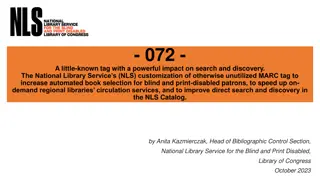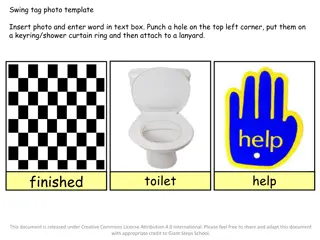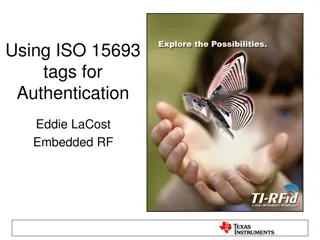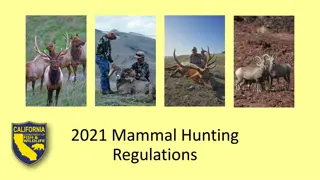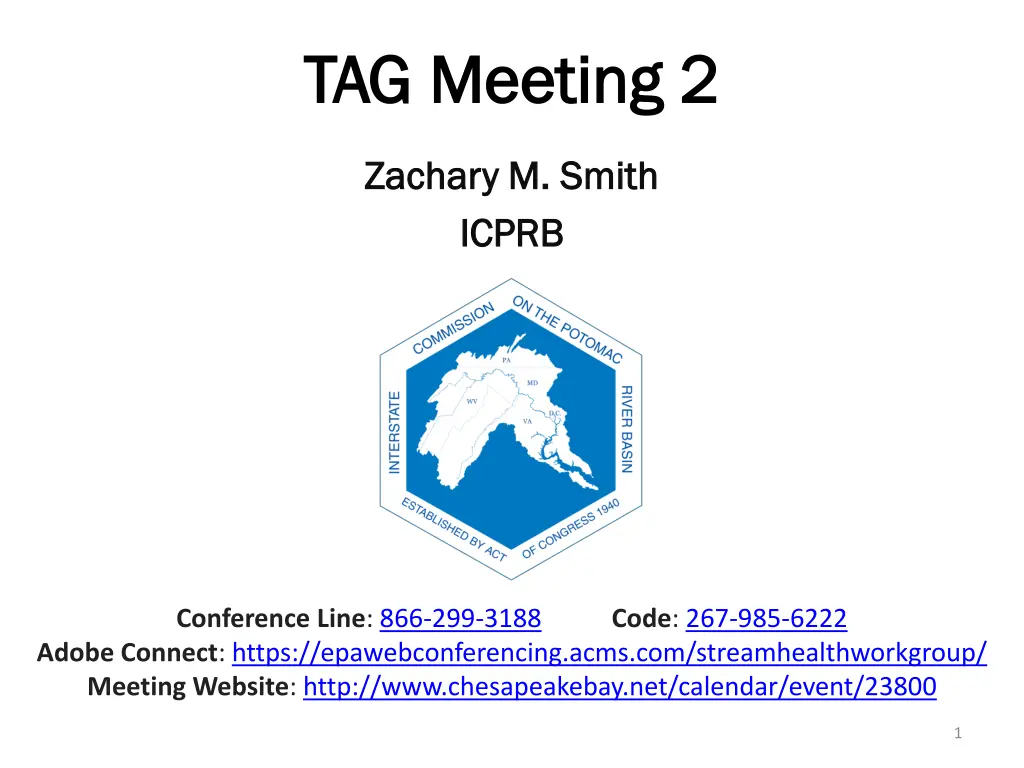
Chesapeake Bay Program Assessment and Taxa Data Overview
Explore the data and objectives of the Chesapeake Bay Program assessment, focusing on taxa lists, tolerance values, and site classifications in the watershed. Join the meeting to discuss refining the 2011 Chessie BIBI for program assessment purposes.
Download Presentation

Please find below an Image/Link to download the presentation.
The content on the website is provided AS IS for your information and personal use only. It may not be sold, licensed, or shared on other websites without obtaining consent from the author. If you encounter any issues during the download, it is possible that the publisher has removed the file from their server.
You are allowed to download the files provided on this website for personal or commercial use, subject to the condition that they are used lawfully. All files are the property of their respective owners.
The content on the website is provided AS IS for your information and personal use only. It may not be sold, licensed, or shared on other websites without obtaining consent from the author.
E N D
Presentation Transcript
TAG Meeting 2 TAG Meeting 2 Zachary M. Smith Zachary M. Smith ICPRB ICPRB Conference Line: 866-299-3188 Adobe Connect: https://epawebconferencing.acms.com/streamhealthworkgroup/ Meeting Website: http://www.chesapeakebay.net/calendar/event/23800 Code: 267-985-6222 1
Objective Objective Update and refine the 2011 Chessie BIBI for Chesapeake Bay Program assessment purposes. 2
Outline Outline Section 1: Master Taxa List Section 2: Site Classification Section 3: Rarefaction Section 4: Metric Sensitivity Section 5: Redundancy Analysis Section 6: Scoring Protocol Section 7: Index Resolution 3
Master Taxa List Master Taxa List Taxa Taxa Freshwater Benthic Macroinvertebrates collected in the Chesapeake Bay watershed 222 of families (151 insect families) 760 of genera (621 insect genera) 11 taxonomic ranks included (ITIS Link) Phylum, subphylum, class, subclass, order, suborder, family, subfamily, tribe, genus, and species 4
Master Taxa List Master Taxa List Common Attributes Common Attributes Municipal Waste Tolerance Values Functional Feeding Groups (FFG) Habits EPA Attributes EPA Attributes (USGS 2006, EPA 2012) Respiratory Type Voltinism Specific Stressors 5
Master Taxa List Master Taxa List Tolerance Values Tolerance Values Mean tolerance values rounded to the nearest integer NAs not included FFGs and Habits FFGs and Habits The most frequent occurring category If max frequencies were equal the categories were concatenated (e.g. SH, CG or CL, CB) 6
Tolerance Values (TV) Tolerance Values (TV) % % Taxa 8 9 9 9 10 11 11 11 12 13 16 17 20 20 20 36 53 69 69 % % % % % % Source Source All All Taxa Order Order 0 0 0 0 0 12 0 0 0 0 0 0 0 0 0 35 23 42 42 Family Family 0 4 1 0 2 16 0 14 0 1 1 1 38 36 37 54 54 69 69 Genus Genus 18 17 20 19 12 19 23 20 27 29 19 37 32 32 31 64 56 79 79 TV TV 0 1 2 3 4 5 6 6 7 8 9 10 n = Frequency Frequency 35 81 138 108 189 184 262 262 137 150 31 29 1,344 EDAS_MD_TV RBP_MID_ATLANTIC_MACS_TV EDAS_NC_TV EDAS_DE_TV RBP_MIDWEST_OH_TV DC_TV EDAS_RBP_TV EDAS_ITIS_TV EDAS_KY_TV EDAS_PA_TV RBP_SOUTHEAST_NC_TV EDAS_WAB_TV EDAS_TV_FINAL EDAS_WV_TV EDAS_FAM_TV EPA_TV NYSDEC_TV BIBI_TV BIBI_TV 7
Functional Feeding Functional Feeding Groups (FFG) Groups (FFG) FFG FFG CF,SC CF,SH CG,CF,PR,P H CG,PR,PH CG,SC,PR PR,PA SC,PR SH,OM SH,SC CG,CF,PR CG,SH PR,PH SH,PR CG,PR PA PH CG,CF SC,OM PR,OM CG,SC CG,OM OM SH CF SC PR CG Frequency Frequency 1 1 1 1 1 1 1 1 1 2 2 2 2 3 3 4 5 5 7 10 12 16 135 145 172 423 443 % % Taxa 11 13 15 19 21 32 41 52 72 72 % % % % % % Source Source All All Taxa Order Order 4 0 0 0 0 21 44 12 52 52 Family Family 14 0 26 41 38 31 63 54 75 75 Genus Genus 19 29 25 30 35 43 73 55 83 83 DC_FFG EDAS_KY_FFG EDAS_ITIS_FFG EDAS_FINAL EDAS_WV_FFG RBP_P_FFG EPA_FFG NYSDEC_FFG BIBI_FFG BIBI_FFG 8
HABIT HABIT BU,SK CB,BU,SP CB,CN,BU SW,BU CB,BU CB,CN,SP CB,SK SW,SP CB,CN CB,SW CN,BU CB,SP CN,SP SW,CN BU,SP SK SW CB BU CN SP Frequency Frequency 1 1 1 1 2 2 2 2 4 4 5 7 7 8 12 15 106 151 183 232 254 Habits Habits % % Taxa % % % % % % Source Source All All Taxa Order Order Family Family Genus Genus EDAS_KY_HABIT 4 0 0 9 DC_HABIT 9 0 12 18 RBP_P_HABIT 15 4 17 22 EDAS__FINAL 16 0 2 35 EDAS_WV_HABIT 21 0 34 34 HABIT_PRIM_ABBREV 38 0 30 71 EPA_HABIT 41 25 62 74 BIBI_HABIT BIBI_HABIT 51 51 25 25 65 65 82 82 9
Unclassified Taxa Unclassified Taxa Taxa without an assigned attribute Find the percentage of taxa in each sample that are unclassified If 10% of the taxa are unclassified the sample is removed from the metric calculation 10
Master Taxa List Master Taxa List Any further comments or question regarding Any further comments or question regarding the master taxa list? the master taxa list? 1. Do you approve of the averaging tolerance values? 2. Do you approve of the concatenating FFGs and habits? 3. Are there any other tables that could be appended? 11
BIBI Workflow BIBI Workflow Site Classification Site Classification Metric Calculation Metric Calculation Metric Sensitivity Metric Sensitivity Redundancy Analysis Redundancy Analysis Metric Selection Metric Selection Scoring Metrics Scoring Metrics 12
Site Classification Site Classification Classes in each bioregion (7) Classes in each bioregion (7) Reference Near Reference Minor Degradation Moderate Degradation Severe Degradation Mixed 13
Site Classification Site Classification 1. Set reference standards 2. Standardize the impact of degradation Six Habitat Parameters x < 16 = 1 x < 5 = 2 Specific Conductivity x > 500 = 1 x > 750 = 2 x > 1,000 = 3 pH x < 6 or x > 8 = 1 x < 5 or x > 9 = 2 14
Site Classification Site Classification 3. Sum the degradation scores 4. Rate on an even scale Reference: x = 0 Near: 1 x < 3 Minor Degradation: 3 x < 6 Moderate Degradation: 6 x < 9 Severe Degradation: x 9 15
0 0 1 1 2 2 3 3 Specific Specific Conductivity Conductivity 500 500 750 750 1,000 1,000 2 2 1 1 0 0 Degradation Degradation Score Score Rabid Habitat Rabid Habitat Assessment Assessment 5 5 16 16 2 2 1 1 0 0 1 1 2 2 pH pH 5 5 6 6 8 8 9 9 16
Class Gradient Class Gradient 100 IBI SCORE 50 0 REF NEAR MOD SEV MIN 17
Biological Condition Gradient Biological Condition Gradient 1 1 2 2 3 3 Biological Condition Biological Condition 4 4 5 5 6 6 Stressor Gradient Stressor Gradient 18
Biological Condition Gradient Biological Condition Gradient 1 1 2 2 3 3 Biological Condition Biological Condition Reference Reference Near Ref. Near Ref. Minor Deg. Minor Deg. 4 4 5 5 6 6 Moderate Deg. Moderate Deg. Severe Deg. Severe Deg. Stressor Gradient Stressor Gradient 19
Metric Calculation Metric Calculation Metrics Metrics 78 metrics from the literature Percentage of each taxon > 1,000 metrics tested Most metrics are useless New Metric New Metric Common Common Metric Metric Bioregion Bioregion % Heptageniidae % Ephemeroptera Piedmont % Systellognatha % Plecoptera Ridges % Furcatergalia % Ephemeroptera Ridges 20
Rarefaction Rarefaction Sampling without replacement Sampling without replacement rrarefy rrarefy function in the Vegan package function in the Vegan package The random rarefaction is made without replacement so that the variance of rarefied communities is rather related to rarefaction proportion than to the size of the sample. - - Oksanen Oksanen and O Hara and O Hara 21
Rarefaction Rarefaction Frequency Frequency Community Composition 22
Family Family EPHEMERELLIDAE HYDROPSYCHIDAE CHIRONOMIDAE TAENIOPTERYGIDAE BAETIDAE LEPIDOSTOMATIDAE LEPTOPHLEBIIDAE TIPULIDAE HEPTAGENIIDAE CHLOROPERLIDAE ISONYCHIIDAE SPERCHONTIDAE PHILOPOTAMIDAE POLYCENTROPODIDAE EMPIDIDAE PERLODIDAE CAPNIIDAE HYDROPTILIDAE GLOSSOSOMATIDAE LUMBRICULIDAE ATHERICIDAE PERLIDAE PSEPHENIDAE LEUCTRIDAE ODONTOCERIDAE PLANARIIDAE RHYACOPHILIDAE SIMULIIDAE Count Count 488 285 142 108 94 71 65 65 54 19 18 18 13 13 9 9 6 6 4 4 2 2 2 1 1 1 1 1 % Abundance % Abundance 33.38 19.49 9.71 7.39 6.43 4.86 4.45 4.45 3.69 1.30 1.23 1.23 0.89 0.89 0.62 100 Rarefied % Abundance Rarefied % Abundance 33 19 10 7 6 5 4 4 4 1 1 1 1 1 1 100 1 2 3 4 5 6 7 8 9 10 11 12 13 14 15 16 17 18 19 20 21 22 23 24 25 26 27 28 23
Min = 8 taxa Min = 8 taxa Median = 15 taxa Median = 15 taxa Max = 23 taxa Max = 23 taxa 24
Min = 1.56 Min = 1.56 Median = 2.12 Median = 2.12 Max = 2.60 Max = 2.60 25
Min = 48% Min = 48% Median = 69% Median = 69% Max = 90% Max = 90% True = 75% True = 75% n = 1052 n = 1052 n nr r= 100 = 100 26
Metric Sensitivity Approaches Metric Sensitivity Approaches Barbour et al. Barbour et al. 1996 1996 Threshold Threshold Quantile Quantile Confusion Matrix Confusion Matrix Accuracy Accuracy Redundancy Analysis Approaches Redundancy Analysis Approaches Pairwise Confusion Matrix Accuracy Wilcoxon Rank Sum Test Scoring Protocol Scoring Protocol Reference Threshold Gradient Reference Gradient Categorical All Gradient 27
Rarefaction Discussion Rarefaction Discussion 28
Metric Sensitivity Metric Sensitivity Objective: Identify metrics that best Objective: Identify metrics that best reflect a reflect a disturbance gradient disturbance gradient 1. Barbour et al. 1996 2. Quantile Threshold 3. Confusion Matrix Accuracy (CMA) 29
Barbour et al. 1996 Barbour et al. 1996 Reference Reference Degraded Degraded 3 points 2 points 1 point 0 points 30
Quantile Threshold Quantile Threshold ?? =? 2 25% 5% ? x 100 x 100 Frequency Frequency Metric Value Metric Value 31
Confusion Matrix Accuracy (CMA) Confusion Matrix Accuracy (CMA) 15% 15% Frequency Frequency Metric Value Metric Value 32
Confusion Matrix Confusion Matrix Predicted Class Predicted Class Reference Reference True Reference (TR) Degraded Degraded False Degraded (FD) Actual Actual Class Class Reference Reference False Reference (FR) True Degraded (TD) Degraded Degraded ?? + ?? ??? =??% + ??% ??? = ?? + ?? + ?? + ?? ???% ? 33
Metric Sensitivity Metric Sensitivity Discussion Discussion 34
Metric Sensitivity Metric Sensitivity Quantile Threshold Barbour et al. 1996 Confusion Matrix Accuracy Redundancy Analysis Redundancy Analysis Pairwise Confusion Matrix Pairwise Confusion Matrix Accuracy Accuracy Wilcoxon Rank Sum Test Wilcoxon Rank Sum Test Scoring Protocol Scoring Protocol Reference Threshold Gradient Reference Gradient Categorical All Gradient 35
Redundancy Analysis Redundancy Analysis Spearman Correlation ( -0.7 or 0.7) Two methods: 1. 1. Wilcoxon Rank Sum Test Wilcoxon Rank Sum Test Pairwise comparison between Reference and Severe Degradation The metric with the smaller p-value is held for further review 2. 2. CMA Pairwise Gradient CMA Pairwise Gradient Class 1 Class 1 Reference Near Reference Minor Degradation Moderate Degradation Severe Degradation Class 2 Class 2 Near Reference Minor Degradation Moderate Degradation Severe Degradation Reference CMA CMA 73 64 57 77 92 72.6 72.6 Mean Mean 36
Redundancy Analysis Redundancy Analysis Spearman Correlation ( -0.7 or 0.7) Two methods: 1. 1. Wilcoxon Rank Sum Test Wilcoxon Rank Sum Test Pairwise comparison between Reference and Severe Degradation The metric with the smaller p-value is held for further review 2. 2. CMA Pairwise Gradient CMA Pairwise Gradient Class 1 Class 1 Reference Near Reference Minor Degradation Moderate Degradation Severe Degradation Class 2 Class 2 Near Reference Minor Degradation Moderate Degradation Severe Degradation Reference CMA CMA 73 64 57 77 92 72.6 72.6 Mean Mean 37
Redundancy Analysis Redundancy Analysis Discussion Discussion 38
Metric Sensitivity Metric Sensitivity Quantile Threshold Barbour et al. 1996 Confusion Matrix Accuracy Redundancy Analysis Redundancy Analysis Pairwise Confusion Matrix Pairwise Confusion Matrix Accuracy Accuracy Wilcoxon Rank Sum Test Wilcoxon Rank Sum Test Scoring Protocol Scoring Protocol Reference Reference Threshold Threshold Gradient Gradient Reference Reference Gradient Gradient Categorical Categorical All Gradient All Gradient 39
Scoring Metrics Scoring Metrics Categorical Scoring Categorical Scoring Three categories: 1, 3, and 5 Metric decreases with degradation x > 50% = 5 25% x 50% = 3 x < 25% = 1 Metric increases with degradation x < 50% = 5 50% x 75% = 3 x > 75% = 1 3 3 1 1 5 5 Frequency Frequency Metric Value Metric Value 40
Gradient Scoring Gradient Scoring Reference Gradient vs. All Gradient Decrease x 5% = 0 x 95% = 100 5% < x < 95% ? ?? ??? ?? * 100 * 100 ????? = Increase x 5% = 100 x 95% = 0 5% < x < 95% ??? ? ??? ?? * 100 * 100 ????? = 41
Reference Gradient Reference Gradient All Gradient All Gradient 1 1 - - 99 99 1 1 - - 99 99 100 100 100 100 0 0 0 0 Frequency Frequency Frequency Frequency Metric Value Metric Value Metric Value Metric Value 42
Threshold Gradient Threshold Gradient Similar to the previous gradient approaches Decrease x 50% = 100 x threshold% = 0 threshold% < x < 50% ? ?? ??? ?? * 100 * 100 ????? = Increase x 50% = 100 x threshold% = 0 50% < x < threshold% ?? ? ?? ??? * 100 * 100 ????? = 43
Threshold Gradient Threshold Gradient 1 1 - - 99 99 0 0 100 100 Threshold % Threshold % 50% 50% Frequency Frequency Metric Value Metric Value 44
Threshold Gradient Threshold Gradient 100 80 IBI SCORE 60 40 20 0 REF NEAR MOD SEV MIN 45
Scoring Protocol Scoring Protocol Discussion Discussion 46
Metric Metric Sensitivity Sensitivity Approach Approach Barbour et al. 1996 Confusion Matrix Accuracy (CMA) Quantile Threshold Redundancy Redundancy Analysis Analysis Approach Approach Wilcoxon Rank Sum Test Pairwise Confusion Matrix Accuracy (CMA) Scoring Scoring Approach Approach All Ref. Threshold Gradient Categorical Gradient Gradient 47
Metric Metric Sensitivity Sensitivity Approach Approach Barbour Barbour et al. et al. 1996 1996 Confusion Matrix Accuracy (CMA) Quantile Threshold Redundancy Redundancy Analysis Analysis Approach Approach Wilcoxon Rank Wilcoxon Rank Sum Test Sum Test Pairwise Confusion Matrix Accuracy (CMA) Scoring Scoring Approach Approach All Ref. Threshold Gradient Categorical Categorical Gradient Gradient 48
Wilcoxon Wilcoxon Redundancy Redundancy Analysis Analysis Barbour et al. Barbour et al. 1996 1996 Categorical Categorical Score Score 49
Metric Metric Sensitivity Sensitivity Approach Approach Barbour et al. 1996 Confusion Matrix Accuracy (CMA) Quantile Quantile Threshold Threshold Redundancy Redundancy Analysis Analysis Approach Approach Wilcoxon Rank Wilcoxon Rank Sum Test Sum Test Pairwise Confusion Matrix Accuracy (CMA) Scoring Scoring Approach Approach All All Ref. Threshold Gradient Categorical Gradient Gradient Gradient 50

